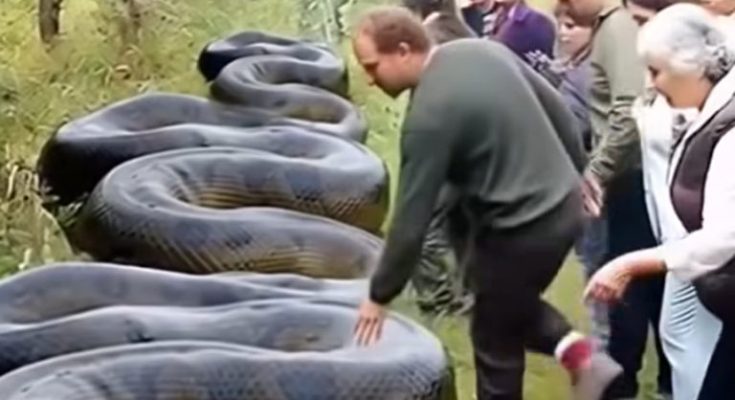Enormous Serpent Discovered by Hiker Close to Creek in South Carolina: A Remarkable Find
Nature often surprises us with incredible encounters, especially along hiking trails where wildlife thrives undisturbed. Such was the case at Jeffries Creek Park in Florence, South Carolina, where hiker Meredith Langley stumbled upon what she described as an enormous snake perfectly blending into its environment. The sighting quickly gained attention online and sparked discussions about trail safety, wildlife awareness, and the beauty of observing animals in their natural habitats.

The Encounter at Jeffries Creek
During a recent family hike, Langley and her children noticed something unusual near the creekside. At first glance, the creature looked like just another part of the forest floor, camouflaged among the fallen leaves and damp earth. On closer inspection, it turned out to be a massive brown water snake stretched across the trail.
“It was a good teaching opportunity and example for my own children who forget not to overtake on the trails!” she explained in her post.
Expert Identification
After photos of the serpent circulated online, wildlife specialist Greg Lucas from the South Carolina Department of Natural Resources (SCDNR) stepped in to provide clarity. He identified the creature as a non-venomous brown water snake, belonging to the genus Nerodia.
According to Lucas, water snakes of this type are often mistaken for venomous species due to their thick, muscular bodies and intimidating size. However, despite their appearance, they pose no venomous threat to humans. He further explained that brown water snakes generally range between 30 and 60 inches in length, with the specimen Langley encountered likely measuring close to four feet when fully extended.

Why Water Snakes Appear So Large
One of the reasons Langley described the snake as “enormous” has to do with its build. Brown water snakes are particularly robust and heavy-bodied compared to other species, which can make them look much larger than they really are. When motionless, their coloration—rich browns and earthy patterns—blends almost invisibly into creek banks, logs, and forest debris.
This camouflage not only helps them avoid predators but also startles hikers who might nearly step on them before realizing what lies at their feet.
Snakes in South Carolina: Venomous vs. Non-Venomous
South Carolina is home to a wide variety of snake species. Among them are harmless water snakes, like the one spotted in Jeffries Creek, and venomous species such as water moccasins (also known as cottonmouths).
Langley herself mentioned that the area hosts both kinds of snakes, which is why caution is always essential when hiking near creeks, swamps, or wetlands. Being able to distinguish between species is vital. While brown water snakes are not venomous, they will defend themselves aggressively if threatened. On the other hand, water moccasins can deliver dangerous bites that require immediate medical attention.

Lessons in Trail Awareness
For Langley, the encounter was more than just a surprise sighting; it became a moment to teach her children about respect for wildlife. She used the opportunity to remind them not to run ahead on trails and to always watch where they step.
Encounters like this highlight a few important principles of safe hiking in areas where snakes are common:
-
Always keep an eye on the ground ahead.
-
Avoid overtaking quickly or running on narrow trails.
-
Give wildlife plenty of space—never attempt to touch or provoke a snake.
-
Teach children to remain calm when spotting wild animals.
By practicing awareness and patience, hikers can coexist safely with the diverse species that inhabit South Carolina’s ecosystems.
The Bigger Picture: Coexisting with Wildlife
Snakes play an essential role in maintaining ecological balance. Brown water snakes, for example, primarily feed on fish and help regulate aquatic populations. Without them, ecosystems near creeks and wetlands would look very different.
Langley’s weekly hikes with her children are a reminder of how important it is to expose young people to nature. Observing wildlife firsthand—whether a harmless snake or a majestic bird—can instill a sense of respect and responsibility toward the environment.
Her story also sheds light on the importance of accurate information. By sharing her experience and having experts clarify the species, the narrative shifted from fear to appreciation. What initially looked like a frightening “giant serpent” turned into a lesson about the wonders of South Carolina’s biodiversity.

Conclusion
The Jeffries Creek Park snake encounter may have startled one family on a quiet day of hiking, but it ultimately provided a valuable reminder: nature is full of surprises, and respecting its inhabitants is key to enjoying it safely. The brown water snake, though intimidating in appearance, is a harmless part of the South Carolina ecosystem.
For hikers, the lesson is simple—stay aware, tread carefully, and remember that we share the trails with creatures that have lived there far longer than we have. What Langley described as an “enormous serpent” turned out to be an extraordinary opportunity to learn, respect, and marvel at the natural world.



